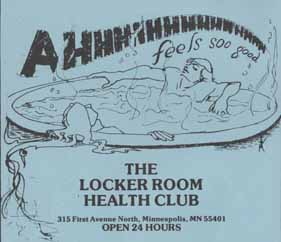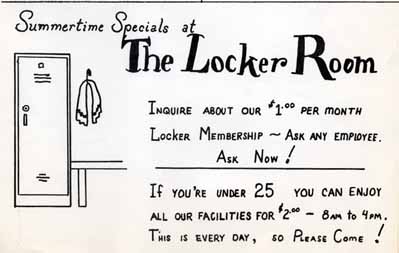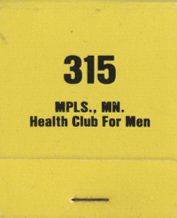Difference between revisions of "Locker Room Baths"
(table) |
|||
| (7 intermediate revisions by 3 users not shown) | |||
| Line 4: | Line 4: | ||
| − | + | {{unprotected}} | |
{| {{prettytable}} | {| {{prettytable}} | ||
! | ! | ||
| Line 17: | Line 17: | ||
| − | It was considered a place for young men, while the Hennepin Avenue Baths [in the lumber Exchange] and Big Daddy’s [in the Patages Theater’s basement] catered to an older crowd. | + | It was considered a place for young men, while the Hennepin Avenue Baths [in the lumber Exchange] and Big Daddy’s [in the Patages Theater’s basement] catered to an older crowd.<small>(1)</small> |
| − | Bathhouses were once a mainstay of urban life in America, as private bathrooms were a luxury only the wealthiest could enjoy in the early 20th century. Citizens used bathhouses for hygienic purposes, though sexual activity assumedly took place even during these “reputable” times. | + | Bathhouses were once a mainstay of urban life in America, as private bathrooms were a luxury only the wealthiest could enjoy in the early 20th century. Citizens used bathhouses for hygienic purposes, though sexual activity assumedly took place even during these “reputable” times.<small>(2)</small> |
|} | |} | ||
| Line 34: | Line 34: | ||
| − | Reportedly, a giant leather phallus and scrotum hung from the ceiling in one of the Locker Room’s many rooms; it underscored a humorous and lighthearted approach to same-sex male sexuality that has since vanished. | + | Reportedly, a giant leather phallus and scrotum hung from the ceiling in one of the Locker Room’s many rooms;<small>(3)</small> it underscored a humorous and lighthearted approach to same-sex male sexuality that has since vanished. |
| Line 45: | Line 45: | ||
| − | The City of Minneapolis did not get | + | The City of Minneapolis did not get the joke. Minneapolis Police, under the auspice of a “Vice Squad,” frequently raided the Locker Room Baths and arrested the employees, the owners, or the clientele. |
| Line 60: | Line 60: | ||
| − | The advent of HIV/AIDS in 1980 led to “Anti-AIDS” ordinances that, in turn, led to further and frequent raids that became progressively more | + | The advent of HIV/AIDS in 1980 led to “Anti-AIDS” ordinances that, in turn, led to further and frequent raids that became progressively more aggressive.<small>(4)</small> Eventually, with a dwindling customer base and inhospitable business conditions, the Locker Room Baths closed in 1988.<small>(5)</small> Its location, within the now-trendy Warehouse District, is presently home to Club Karma. |
|} | |} | ||
---- | ---- | ||
| + | ==This entry is part of:== | ||
| + | == [[Minneapolis/St. Paul, MN: 100 Queer Places in Minnesota History, (1860-2010)]]== | ||
| + | ---- | ||
| + | |||
| + | |||
| + | <small>(1)</small>Tretter, Jean-Nickolaus. Interview with the author and Jacob Gentz. 1/16/2009. | ||
| + | |||
| + | <small>(2)</small>Williams, Marilyn T. ''Washing the Great Unwashed: Public Baths in Urban America: 1840-1920.'' Ohio: Ohio University Press, 1991. | ||
| + | <small>(3)</small>http://gaytubs.blogspot.com/2006/12/history-of-gay-bath-houses-blog.html. "THE LOCKER ROOM - MINNEAPOLIS 1976 - 1982 [sic]" comment submitted by "Greg" 1/24/2007 | ||
| − | + | <small>(4)</small> Ritter, John. "New Ordinance may Close Bathhouse." [[Equal Time]] issue 152, 2/3/1988. Page 7. | |
| − | + | <small>(5)</small>Ritter, John. "315 Health Club closes prior to ordinance." [[Equal Time]] news, Issue 157. 4/13/1988. | |
Latest revision as of 01:59, 20 January 2012
315 1st Avenue North, Minneapolis
| Locker Room Ad, 1980. courtesy of the Jean-Nickolaus Tretter Collection. |
The Locker Room was a a place of anonymous sex and cross-cultural encounters, where men could enter, pay a small price for a locker to store street clothes, and wander in a state of undress searching for available sex partners.
|
As time progressed, ageing bathhouses came under new ownership and discarded all pretense of non-sexual services. Instead, and amid a 1970s culture of unabashed sexuality, the bathhouses advertised their services in queer publications.
| The Locker Room began as an offshoot of Sutton’s Place, a gay bar located at 1st Ave N. and 7th St. (where the Target Center now stands). The bathhouse and bar eventually separated ways, and the bathhouse moved to a run-down warehouse.
|
Locker Room Ad, 1977. Courtesy of the Jean-Nickolaus Tretter Collection. |
The City of Minneapolis did not get the joke. Minneapolis Police, under the auspice of a “Vice Squad,” frequently raided the Locker Room Baths and arrested the employees, the owners, or the clientele.
| Locker Room matchbook, Courtesy of the Jean-Nickolaus Tretter Collection. |
These raids were so common that the Locker Room’s helpful staff printed escape pamphlets in the event of the arrests and, for a short time, the police and gay bathhouses achieved an unsteady truce.
|
This entry is part of:
Minneapolis/St. Paul, MN: 100 Queer Places in Minnesota History, (1860-2010)
(1)Tretter, Jean-Nickolaus. Interview with the author and Jacob Gentz. 1/16/2009.
(2)Williams, Marilyn T. Washing the Great Unwashed: Public Baths in Urban America: 1840-1920. Ohio: Ohio University Press, 1991.
(3)http://gaytubs.blogspot.com/2006/12/history-of-gay-bath-houses-blog.html. "THE LOCKER ROOM - MINNEAPOLIS 1976 - 1982 [sic]" comment submitted by "Greg" 1/24/2007
(4) Ritter, John. "New Ordinance may Close Bathhouse." Equal Time issue 152, 2/3/1988. Page 7.
(5)Ritter, John. "315 Health Club closes prior to ordinance." Equal Time news, Issue 157. 4/13/1988.


